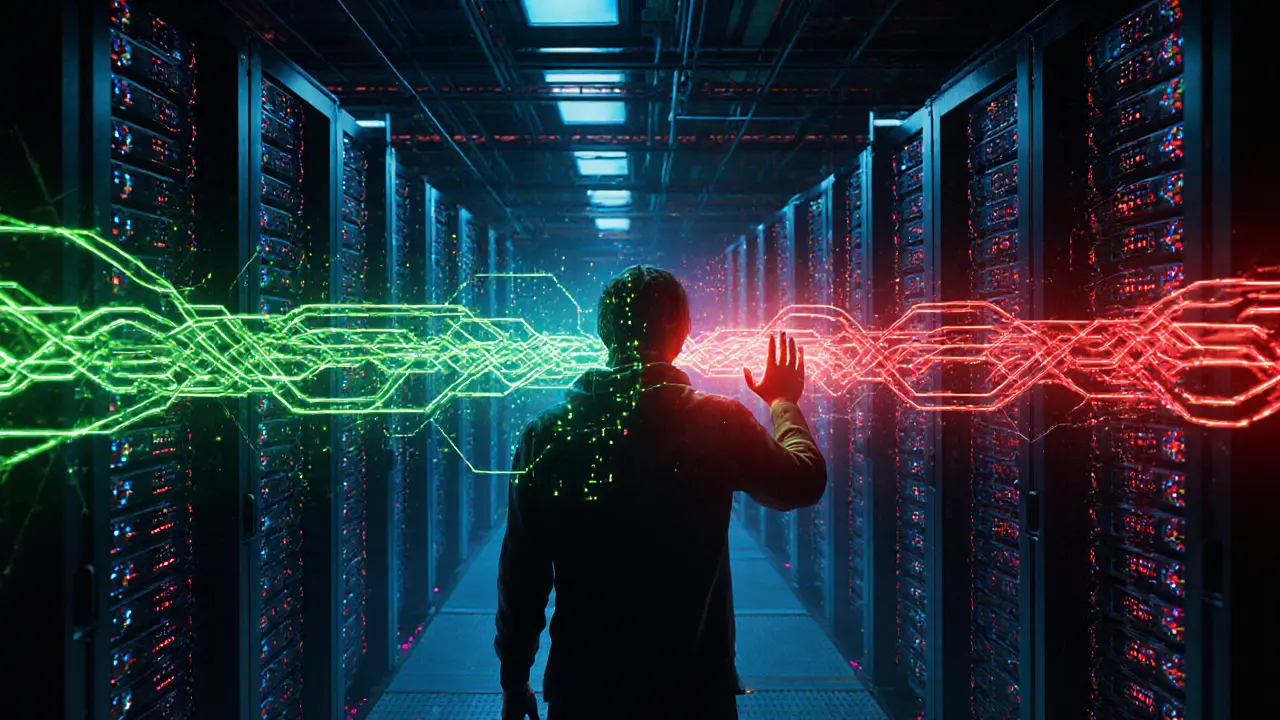Imagine buying a coffee with Bitcoin. The transaction goes through. You get your drink. Then, just minutes later, the seller finds out the money never actually left your wallet. The coins were spent twice. That’s not a glitch. That’s a 51% attack - and it’s happened before.
What Is a 51% Attack?
A 51% attack happens when one person or group controls more than half of a blockchain’s mining power. This isn’t about hacking passwords or breaking encryption. It’s about brute force. If you control the majority of the network’s computing power, you can out-mine everyone else and rewrite history. Blockchains like Bitcoin use something called proof-of-work to confirm transactions. Miners compete to solve complex math problems. The first one to solve it gets to add the next block and earn a reward. The network always trusts the longest chain - the one with the most work behind it. That’s the rule. But if you control more than 50% of the mining power, you can build a longer chain faster than the rest of the network. And when you do, the network follows you.How Double-Spending Works
Double-spending is the goal. Here’s how it plays out in real time:- You send 10 Bitcoin to a merchant for a laptop.
- The merchant waits for one confirmation - a block added on top of your transaction. It looks legit.
- At the same time, you secretly start mining a new chain that doesn’t include that transaction.
- You add a different transaction on your secret chain: sending those same 10 Bitcoin to another wallet you control.
- Once your secret chain is longer than the public one, the network switches to it.
- The original transaction vanishes. The merchant gets nothing. You keep the laptop and the coins.
Why Bitcoin Is Safe - For Now
Bitcoin’s network is huge. It uses more electricity than most countries. The cost to rent enough mining power to take over Bitcoin’s network would be in the billions. Even if you could afford it, the attack would crash Bitcoin’s price. Your stolen coins would be worth less than the money you spent to steal them. MIT’s Digital Currency Initiative says Satoshi Nakamoto designed Bitcoin this way on purpose. The idea was simple: make it so expensive to attack the network that it’s not worth it. For Bitcoin, that still holds true. No one has successfully pulled off a 51% attack on Bitcoin since its launch in 2009.Where It Actually Happens
The real danger isn’t Bitcoin. It’s the smaller coins. Ethereum Classic (ETC) got hit in 2019. Attackers reorganized 100+ blocks. They double-spent over $5 million. Bitcoin Gold (BTG) suffered similar attacks in 2020. These networks don’t have the mining power of Bitcoin. Their hash rate is low. That means a small group of miners - or even one well-funded entity - can temporarily rent enough power from services like NiceHash to control the network. Think of it like a small town with only 100 voters. If you bribe 51 of them, you control the election. That’s what happens on small blockchains. Miners from Bitcoin or Ethereum switch over for a few hours, mine a secret chain, cash out, and leave. The network is left broken, and trust is gone.
What an Attack Can - and Can’t - Do
There’s a big myth out there: that a 51% attack lets you steal anyone’s coins. It doesn’t. You can’t:- Change someone else’s wallet balance
- Create new coins out of thin air
- Modify smart contracts
- Force transactions you didn’t sign
- Reverse your own transactions
- Block new transactions from confirming
- Prevent others from mining blocks
The Economic Trap
Here’s the twist: even if you succeed, you might lose money. After a 51% attack, the price of the coin usually crashes. Investors panic. Exchanges suspend trading. Miners flee. The network becomes less secure. The attacker’s stolen coins are now worth less. And if they tried to cash out, they’d flood the market and crash the price even more. Some attackers aren’t after profit. They’re after revenge. Or sabotage. Or to prove a point. That’s why some attacks happen even when the math doesn’t add up.How to Spot a Vulnerable Network
Not all blockchains are created equal. Here’s how to tell if a coin is at risk:- Is its hash rate under 100 TH/s? (Bitcoin’s is over 800,000 TH/s)
- Do three mining pools control more than 60% of the hash rate?
- Is the coin traded on only a few exchanges?
- Has it been attacked before?

What’s Being Done to Stop It
The industry is fighting back. Some projects are switching from proof-of-work to proof-of-stake. Ethereum did it in 2022. Proof-of-stake doesn’t rely on mining power. It relies on who has the most coins at stake. You can’t rent 51% of Ethereum’s coins like you can rent mining hardware. Other networks use checkpointing. Trusted nodes lock in certain blocks so they can’t be rewritten. Some use hybrid systems - proof-of-work for mining, proof-of-stake for finality. Monitoring services now alert exchanges and wallets when hash rate spikes suddenly. If a small coin’s hash rate doubles overnight, it’s a warning sign. The community watches for these patterns.What You Should Do
If you’re a user:- Avoid sending large amounts to small, low-hash-rate coins.
- Wait for at least 6 confirmations before trusting a transaction.
- Check if the coin has been attacked before - search for "[coin name] 51% attack".
- Don’t assume decentralization. Check actual mining distribution.
- Ask: "Can a single entity rent enough power to take over this network?"
- Support projects that use proof-of-stake or hybrid security models.
The Bigger Picture
The 51% attack isn’t just a technical flaw. It’s an economic one. It shows that trust in blockchain isn’t about code - it’s about cost. The more expensive it is to attack, the more secure the network becomes. Bitcoin’s security isn’t because it’s perfect. It’s because it’s too expensive to break. Smaller chains are trying to copy Bitcoin’s success without paying the same price. But without the hash rate, they’re sitting ducks. The market is already sorting them out. Coins that can’t defend themselves lose value. Investors move on. The future of blockchain isn’t about more coins. It’s about stronger ones.Can a 51% attack steal my Bitcoin from my wallet?
No. A 51% attack can’t access or steal coins from any wallet. It can only reverse transactions that were sent from addresses controlled by the attacker. Your private keys remain safe. The attack targets the blockchain’s record, not your wallet.
Has Bitcoin ever been successfully attacked with a 51% attack?
No. Bitcoin has never been successfully attacked with a 51% attack. Its massive hash rate - over 800,000 terahashes per second - makes it economically impossible for any single entity to gain control. The cost of the hardware, electricity, and time required far exceeds any potential gain.
Which cryptocurrencies are most vulnerable to 51% attacks?
Smaller cryptocurrencies with low hash rates are most vulnerable. Ethereum Classic (ETC) and Bitcoin Gold (BTG) have both been successfully attacked. Other targets include Verge, Monacoin, and Zcash - especially when their hash rate drops below 100 TH/s. Networks with centralized mining pools are at higher risk.
Can you rent mining power to launch a 51% attack?
Yes. Services like NiceHash let you rent hash power by the hour. In 2019, attackers rented enough power to take over Ethereum Classic for several hours. The cost was under $100,000 - and they stole over $5 million. This is why small blockchains are at risk: the barrier to entry is low.
How many confirmations are safe from a 51% attack?
For Bitcoin, 6 confirmations (about one hour) is considered safe. For smaller coins, you may need 20 or more. If a network has been attacked before, wait for 50+ confirmations. The more blocks added on top of your transaction, the harder it is to rewrite the chain.
Are proof-of-stake blockchains immune to 51% attacks?
They’re not vulnerable to the same kind of attack. In proof-of-stake, you need to own 51% of the total coins to control the network - not just rent hardware. That’s far more expensive and self-defeating, since you’d be destroying the value of your own holdings. Ethereum, Cardano, and Solana use this model to avoid 51% attacks entirely.






Comments
2 Comments
Kris Young
So, if you control 51% of the hash rate, you can undo transactions? That’s wild. I always thought blockchain was immutable. Turns out, it’s just really expensive to break.
But yeah, this makes sense. Bitcoin’s safe because it’s too costly to attack. Smaller coins? Not so much.
LaTanya Orr
It’s not about the code being perfect. It’s about the cost of breaking it. That’s the real innovation. Satoshi didn’t build an unbreakable system. He built one where breaking it makes you broke.
That’s philosophy disguised as cryptography.
Write a comment